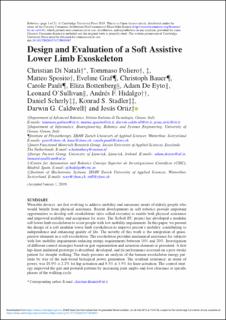Please use this identifier to cite or link to this item:
https://doi.org/10.21256/zhaw-3364Full metadata record
| DC Field | Value | Language |
|---|---|---|
| dc.contributor.author | Di Natali, Christian | - |
| dc.contributor.author | Poliero, Tommaso | - |
| dc.contributor.author | Sposito, Matteo | - |
| dc.contributor.author | Graf, Eveline | - |
| dc.contributor.author | Bauer, Christoph | - |
| dc.contributor.author | Pauli, Carole | - |
| dc.contributor.author | Bottenberg, Eliza | - |
| dc.contributor.author | De Eyto, Adam | - |
| dc.contributor.author | O’Sullivan, Leonard | - |
| dc.contributor.author | Hidalgo, Andrés F. | - |
| dc.contributor.author | Scherly, Daniel | - |
| dc.contributor.author | Stadler, Konrad S. | - |
| dc.contributor.author | Caldwell, Darwin G. | - |
| dc.contributor.author | Ortiz, Jesús | - |
| dc.date.accessioned | 2019-02-26T17:33:43Z | - |
| dc.date.available | 2019-02-26T17:33:43Z | - |
| dc.date.issued | 2019-02-26 | - |
| dc.identifier.issn | 0263-5747 | de_CH |
| dc.identifier.issn | 1469-8668 | de_CH |
| dc.identifier.uri | https://digitalcollection.zhaw.ch/handle/11475/15681 | - |
| dc.description.abstract | Wearable devices are fast evolving to address mobility and autonomy needs of elderly people who would benefit from physical assistance. Recent developments in soft robotics provide important opportunities to develop soft exoskeletons (also called exosuits) to enable both physical assistance and improved usability and acceptance for users. The XoSoft EU project has developed a modular soft lower limb exoskeleton to assist people with low mobility impairments. In this paper, we present the design of a soft modular lower limb exoskeleton to improve person’s mobility, contributing to independence and enhancing quality of life. The novelty of this work is the integration of quasi-passive elements in a soft exoskeleton. The exoskeleton provides mechanical assistance for subjects with low mobility impairments reducing energy requirements between 10% and 20%. Investigation of different control strategies based on gait segmentation and actuation elements is presented. A first hip–knee unilateral prototype is described, developed, and its performance assessed on a post-stroke patient for straight walking. The study presents an analysis of the human–exoskeleton energy patterns by way of the task-based biological power generation. The resultant assistance, in terms of power, was 10.9% ± 2.2% for hip actuation and 9.3% ± 3.5% for knee actuation. The control strategy improved the gait and postural patterns by increasing joint angles and foot clearance at specific phases of the walking cycle. | de_CH |
| dc.language.iso | en | de_CH |
| dc.publisher | Cambridge University Press | de_CH |
| dc.relation.ispartof | Robotica | de_CH |
| dc.rights | https://creativecommons.org/licenses/by-nc-sa/4.0/ | de_CH |
| dc.subject.ddc | 620: Ingenieurwesen | de_CH |
| dc.title | Design and evaluation of a soft assistive lower limb exoskeleton | de_CH |
| dc.type | Beitrag in wissenschaftlicher Zeitschrift | de_CH |
| dcterms.type | Text | de_CH |
| zhaw.departement | Gesundheit | de_CH |
| zhaw.departement | School of Engineering | de_CH |
| zhaw.organisationalunit | Institut für Mechatronische Systeme (IMS) | de_CH |
| zhaw.organisationalunit | Institut für Physiotherapie (IPT) | de_CH |
| dc.identifier.doi | 10.1017/S0263574719000067 | de_CH |
| dc.identifier.doi | 10.21256/zhaw-3364 | - |
| zhaw.funding.eu | info:eu-repo/grantAgreement/EC/H2020/688175//Soft modular biomimetic exoskeleton to assist people with mobility impairments/ | de_CH |
| zhaw.issue | 12 | de_CH |
| zhaw.originated.zhaw | Yes | de_CH |
| zhaw.pages.end | 2034 | de_CH |
| zhaw.pages.start | 2014 | de_CH |
| zhaw.publication.status | publishedVersion | de_CH |
| zhaw.volume | 37 | de_CH |
| zhaw.publication.review | Peer review (Publikation) | de_CH |
| zhaw.webfeed | Angewandte Gerontologie | de_CH |
| zhaw.webfeed | ZHAW digital | de_CH |
| Appears in collections: | Publikationen Gesundheit | |
Files in This Item:
| File | Description | Size | Format | |
|---|---|---|---|---|
| design_and_evaluation_of_a_soft_assistive_lower_limb_exoskeleton.pdf | 1.93 MB | Adobe PDF |  View/Open |
Show simple item record
Di Natali, C., Poliero, T., Sposito, M., Graf, E., Bauer, C., Pauli, C., Bottenberg, E., De Eyto, A., O’Sullivan, L., Hidalgo, A. F., Scherly, D., Stadler, K. S., Caldwell, D. G., & Ortiz, J. (2019). Design and evaluation of a soft assistive lower limb exoskeleton. Robotica, 37(12), 2014–2034. https://doi.org/10.1017/S0263574719000067
Di Natali, C. et al. (2019) ‘Design and evaluation of a soft assistive lower limb exoskeleton’, Robotica, 37(12), pp. 2014–2034. Available at: https://doi.org/10.1017/S0263574719000067.
C. Di Natali et al., “Design and evaluation of a soft assistive lower limb exoskeleton,” Robotica, vol. 37, no. 12, pp. 2014–2034, Feb. 2019, doi: 10.1017/S0263574719000067.
DI NATALI, Christian, Tommaso POLIERO, Matteo SPOSITO, Eveline GRAF, Christoph BAUER, Carole PAULI, Eliza BOTTENBERG, Adam DE EYTO, Leonard O’SULLIVAN, Andrés F. HIDALGO, Daniel SCHERLY, Konrad S. STADLER, Darwin G. CALDWELL und Jesús ORTIZ, 2019. Design and evaluation of a soft assistive lower limb exoskeleton. Robotica. 26 Februar 2019. Bd. 37, Nr. 12, S. 2014–2034. DOI 10.1017/S0263574719000067
Di Natali, Christian, Tommaso Poliero, Matteo Sposito, Eveline Graf, Christoph Bauer, Carole Pauli, Eliza Bottenberg, et al. 2019. “Design and Evaluation of a Soft Assistive Lower Limb Exoskeleton.” Robotica 37 (12): 2014–34. https://doi.org/10.1017/S0263574719000067.
Di Natali, Christian, et al. “Design and Evaluation of a Soft Assistive Lower Limb Exoskeleton.” Robotica, vol. 37, no. 12, Feb. 2019, pp. 2014–34, https://doi.org/10.1017/S0263574719000067.
Items in DSpace are protected by copyright, with all rights reserved, unless otherwise indicated.